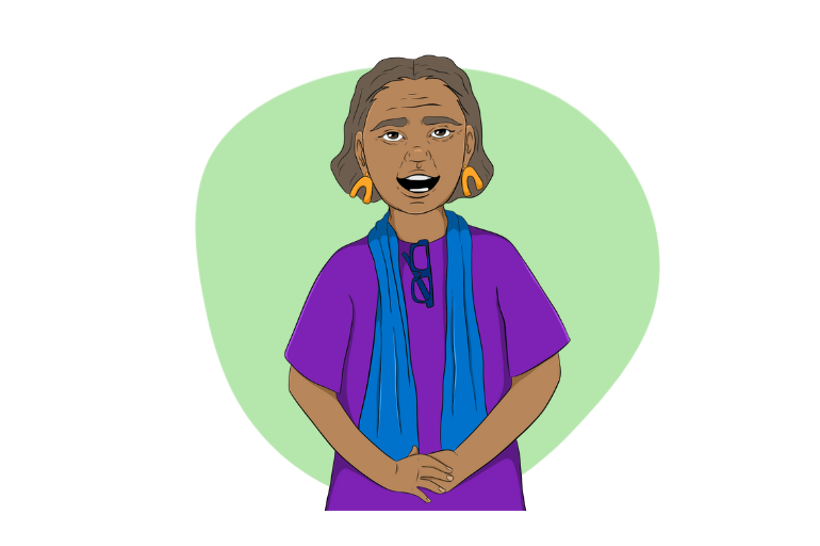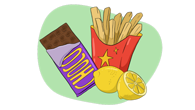
A lot of our knowledge from our Elders has been lost...
so we have to share to keep the culture going.
.

How do I learn about foods from my Country?
If you’re not sure, see what’s available in your area. If you are connected to Elders in your area, they often have knowledge to share.

Places like Land councils, Aboriginal Medical Services and community gardens can have information about what’s in your community.
Sometimes local shops have bush foods (depending on your region). Or family members bringing it from country or hunting.
|
What is it? |
Health benefit | How to use it |
|
Warrigal Greens Coastal areas. |
High amounts of vitamin K. | Warrigal greens must be quickly cooked in hot or boiling water to remove bitterness. |
|
Bush tomato Central Australia. |
A rich source of minerals, particularly potassium, and vitamin C. | Added to salads, as a marinade, added to damper. The sun-dried fruits are harvested in the autumn and winter and store well for several years. |
|
Yongka (Kangaroo) Sometimes available in supermarkets. |
High in protein, low in fat source of Iron. | Yongka (Kangaroo) Sometimes available in supermarkets High in protein, low in fat source of Iron. Yongka (kangaroo) is used in many cooking recipes. Such as stews, curries, casseroles, kebab skewers. If prepared the correctly can be made into steaks. |
|
Yenggi (Bunya) nut S/E Queensland originally. |
An excellent gluten free source of carbohydrate and protein, low in fat. | The cones will fall from the tree when mature so stay clear of the trees at that time. You can split the cones by dropping them on concrete or a hard surface however the membrane containing the husks will fall off within a week to 10 days. Roast them on a fire, grind into a paste or flour, cooked up into little cakes, or eat them raw, boiled, or roasted in coals. |
|
Karkalla (pig face) Coastal and inland plains. |
Karkalla is an excellent source of fibre, iron, and calcium, and also contains some vitamin C. Karkalla is known to be an anti-inflammatory and loaded with antioxidants. |
Every part of the common beach plant is edible – raw or cooked – the leaves, the flowers and the fruits. You can use roasted leaves as a salt substitute. The leaves are predominately served with meat, and the fruit eaten fresh or dried. It contains a lot of drinkable moisture and is a good source of water in a survival situation.It can also be used as a gargle for sore throat and mild bacterial mouth infections and its juices from succulent leaves help to soothe itches, bites and burns. |
|
Orray (Davidsons plum) In the rainforests of NSW and QLD. |
Very high in antioxidants, contains potassium, folate, calcium and magnesium zinc and vitamin E. | Primarily eaten raw and its flavour lends itself to sweet and savoury dishes. |
| Bunurra (Goanna) | Traditionally goanna is cooked whole on the ashes of a fire. | |
|
Emu Inland areas of Australia. |
Emu meat is a low-fat, high-protein food that is also a good source of essential vitamins and minerals. It contains iron, vitamin C, calcium, and omega-3 fatty acid. | Emu can be roasted, grilled, pan-fried (steaks), or used for making kebabs with different vegetables on skewers and cooked over a BBQ or campfire. Emu eggs can also be eaten and used just like normal eggs. |
|
Duggies (yabby) Often in creeks and dams across the country. |
Good source of protein and low in fat. | Boiled in pot of water over the campfire/stove. Also, can be steamed or cooked in the coal of the fire. |
| Grubs (witchetty grubs) | High in protein. | Witchetty grub scan be eaten raw or cooked. Live & raw – biting the bottom portion of the grub and discarding the rest. The head is never eaten.The raw grub has a slightly sweet flavour and liquid centre. Lightly grilled or cooked in hot ashes, which makes the skin crisp and the inside gooey. The cooked grub has a similar taste to almond. |
| Quandong | Considered a superfood. Rich in Vitamin C, Vitamin E, folate, magnesium, zinc, iron and calcium. |
Quandong can be used to make jams, cakes, relishes |
| Lemon myrtle | Contains vitamins A and E and high in minerals such as calcium, magnesium and zinc. It is a source of folate. It supports the immune system and digestion. | Lemon myrtle can be used in so many ways such as baking, marinades/rubs, syrups, and drinks such as tea. Can be used to make Lemon myrtle butter to have on damper. Other ways lemon myrtle is used is wrapping the leaves in paperbark to flavour fish dishes, and to treat headaches by crushing and inhaling the leaves. |
| Marron | Marron is very high in healthy omega - 3 fatty acids and low in calories. | Marron can be steamed, poached, deep-fried, pan-fried, stir-fried, baked, grilled or even on the BBQ. The head and shell can be used to flavour stocks, soups and sauces. |
| Wallaby | High in protein, low in fat source of Iron. | Can be used in many cooking recipes. Such as stews, curries, casseroles, kebab skewers. If prepared the correctly can be made into steaks. |
| Fish including salmon | Good source of protein and omega 3 fatty acids. Can reduce inflammation. | Fresh fish including salmon can be filleted and cooked over an open fire. Firm fish can be added to stews. |
| Prawns | Very high in healthy omega - 3 fatty acids and low in calories. | Prawns can be steamed, poached, deep-fried, pan-fried, stir-fried, baked, grilled or even on the BBQ. The head and shell can be used to flavour stocks, soups and sauces. |
|
Pipis Mainly from the NSW-QLD border right down to the Great Australian Bight in South Australia |
Pipis are naturally rich in omega-3 fatty acids. good source of trace minerals such copper, iodine and zinc. Also contain iron and potassium. |
Traditionally pipis were pulled from the sand, cooked on hot coals or mud ovens, then eaten on the beach. They can steamed, added to soups or simply thrown on the barbecue with garlic and oil. Pips can also be poached, stir-fried, baked, grilled, smoked, raw (sashimi), or pickled. |
| Damper (bush bread) | Carbohydrate |
Originally made from flour of crushed native seeds. Used to grind the seeds into flour and water was added to form a dough. Can be baked in the oven at home or over the campfire covered by the ashes or in a camp pot. Damper can be eaten by itself with butter jam, honey, golden syrup, lemon myrtle butter etc. Damper also can be used as your bread to have on the side of stews/soups. |
| Honey ants | The honey sack attached to the ant is eaten, but not the ant itself. Collected in bark strips. | |
| Lobster | Rich source of protein, good source of B vitamins, and it also offers a broad range of minerals. | Lobster can be steamed, poached, deep-fried, pan-fried, stir-fried, baked, grilled or even on the BBQ. The head and shell can be used to flavour stocks, soups and sauces. |
Note: We would like to acknowledge that this information was created with the help of Noongar women.


